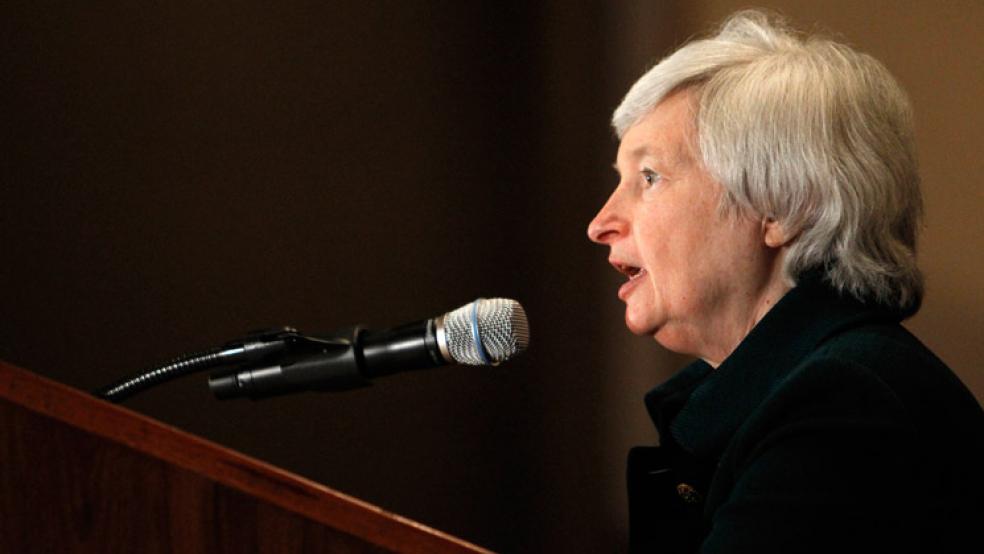Most of the suspense surrounding this week’s meeting of the Federal Open Market Committee has less to do with the Fed’s asset purchase program (it will likely continue the “taper” by again slowing the pace of its purchases) or interest rates (they will hold them steady).
It has everything to do with how Fed Chair Janet Yellen articulates the path forward in her first meeting with the press Wednesday afternoon.
In guidance released last year, the central bank sought to calm market concerns about potential interest rate increases by laying out a quantitative threshold that committee members would be watching as they considered whether it was time to start raising interest rates again. Instead of just promising that interest rates would stay close to zero until, say, mid-2015, the Fed signaled it would hold steady until the unemployment rate had fallen to 6.5 percent as long as inflation also didn’t rise above 2.5 percent.
That unemployment figure is now within sight. The economy could easily reach it with a month or two of solid job creation, given that the rate currently stands at 6.7 percent.
Related: Yellen’s High-Stakes Challenge on Unemployment
The Fed, being the Fed, has been very careful about the language officials have used when discussing interest rate policies, and they have been quite clear that the 6.5 percent figure is a threshold, not a trigger for action. More recently, the bank’s policymakers have made clear that they will keep rates low well past the point that threshold is reached.
So nobody expects a sudden spike in interest rates coming out of this week’s two-day meeting or, indeed, any time this year. But businesses and investors plan for the long-term as well as the short-term, and Yellen will have to address the impact falling unemployment has on the FOMC’s thinking, even if actual policy movements are unlikely in the near term.
It’s clear that Yellen will have to lay out a new way to signal the Fed’s intentions – something more qualitative and open to interpretation – than relying on a hard number that could cause the market to make assumptions about imminent interest rate moves. The central bankers have already shifted their emphasis to that so-called “forward guidance,” but markets and Fed watchers will be eager to hear more about just what indicators Yellen and her colleagues will be watching.
Michael Feroli, a research analyst at J.P. Morgan predicted that Yellen would use the FOMC’s post-meeting statement, as well as her meeting with the press to help smooth the transition from quantitative to more qualitative guidance.
“Recent Fed-speak has increasingly focused on what Atlanta Fed President Lockhart has called the ‘shadow labor force,’ Feroli wrote in a research note. “In particular, the statement could begin to reference a desire to see lower levels of part-time employment for economic reasons and in measured marginal attachment to the labor force, such as discouraged workers.”
Related: Yellen Says Fed Needs “Firmer Handle” on Soft Data
Analysts at Nomura Securities said that while they expect the FOMC to jettison most of the quantitative aspects of forward guidance, they believe policymakers will retain language indicating that they “will maintain a low interest rate if projected inflation continues to run below the committee's 2 percent longer-run goal.”
The need for the Fed to adjust its forward guidance, interestingly, comes just a week after the influential Bank for International Settlements published a paper calling into question the overall usefulness of forward guidance as a tool.
The paper concluded, “The recent increased reliance on forward guidance has been helpful in clarifying policy intentions in highly unusual economic circumstances. However, the mixed evidence concerning the effectiveness of these practices, and the challenges they raise, caution against drawing firm conclusions about their ultimate value.”
Given that Yellen was an early supporter of aggressive forward guidance from the Fed, and that she has signaled that policies under her leadership will be largely consistent with those under her predecessor, Ben Bernanke, whatever the market hears on Wednesday will likely reflect a change in nuance rather than a change in overall philosophy.
Top Reads from The Fiscal Times
- Inequality in Capitalist Systems Is Not Inevitable
- These Top Economists All Agree on the Biggest Problem the U.S. Faces
- Americans Are Racking Up Debt Again. Should We Be Scared?





